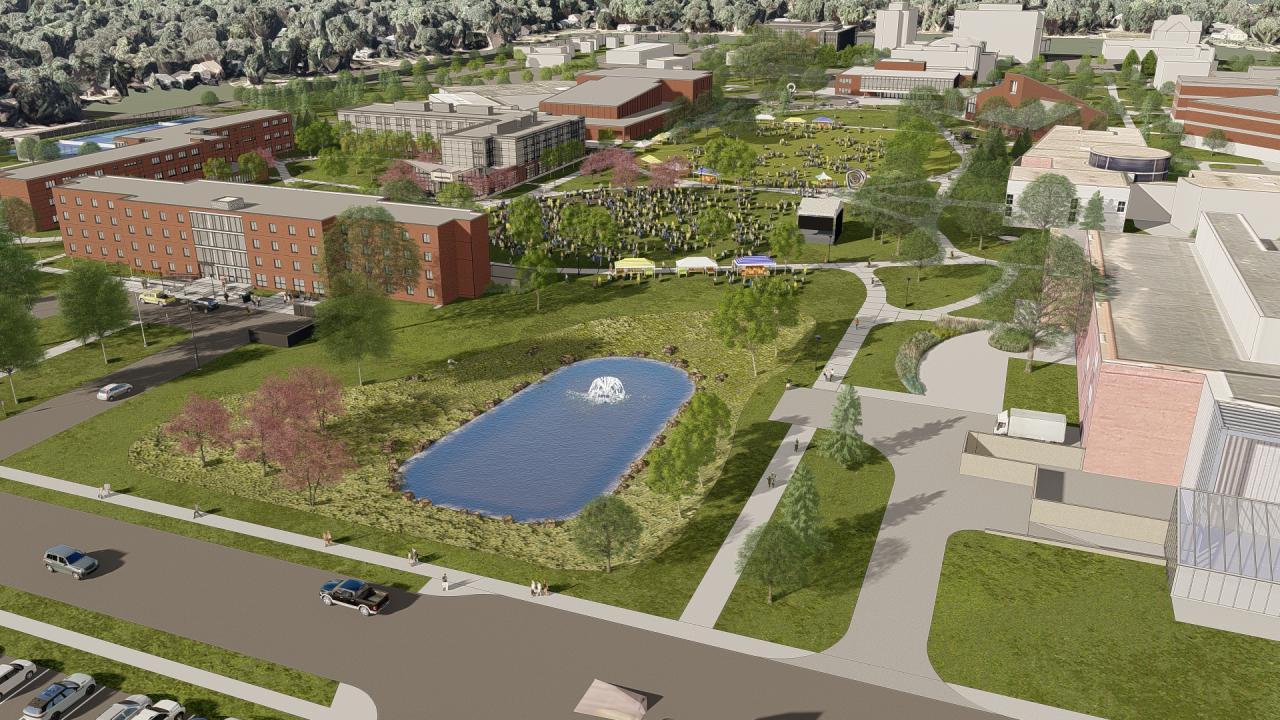Private four-year academic institutions provide more space per in-person student than other sectors. Town and rural schools provide more space per in-person student than urban and suburban schools. Institutions with fewer than 5,000 in-person students offer the most instructional space per in-person student. And small public four-year institutions provide much more research lab space than small private four-year schools.
These are some of the findings in the Society for College and University Planning’s 2022 Campus Facilities Inventory Report. CFI is a national database that helps universities compare their campus development to peer institutions. The quantitative section of the 2022 Report is based on responses from 104 institutions across the U.S. and one in Canada, and its results were released a few weeks ago.
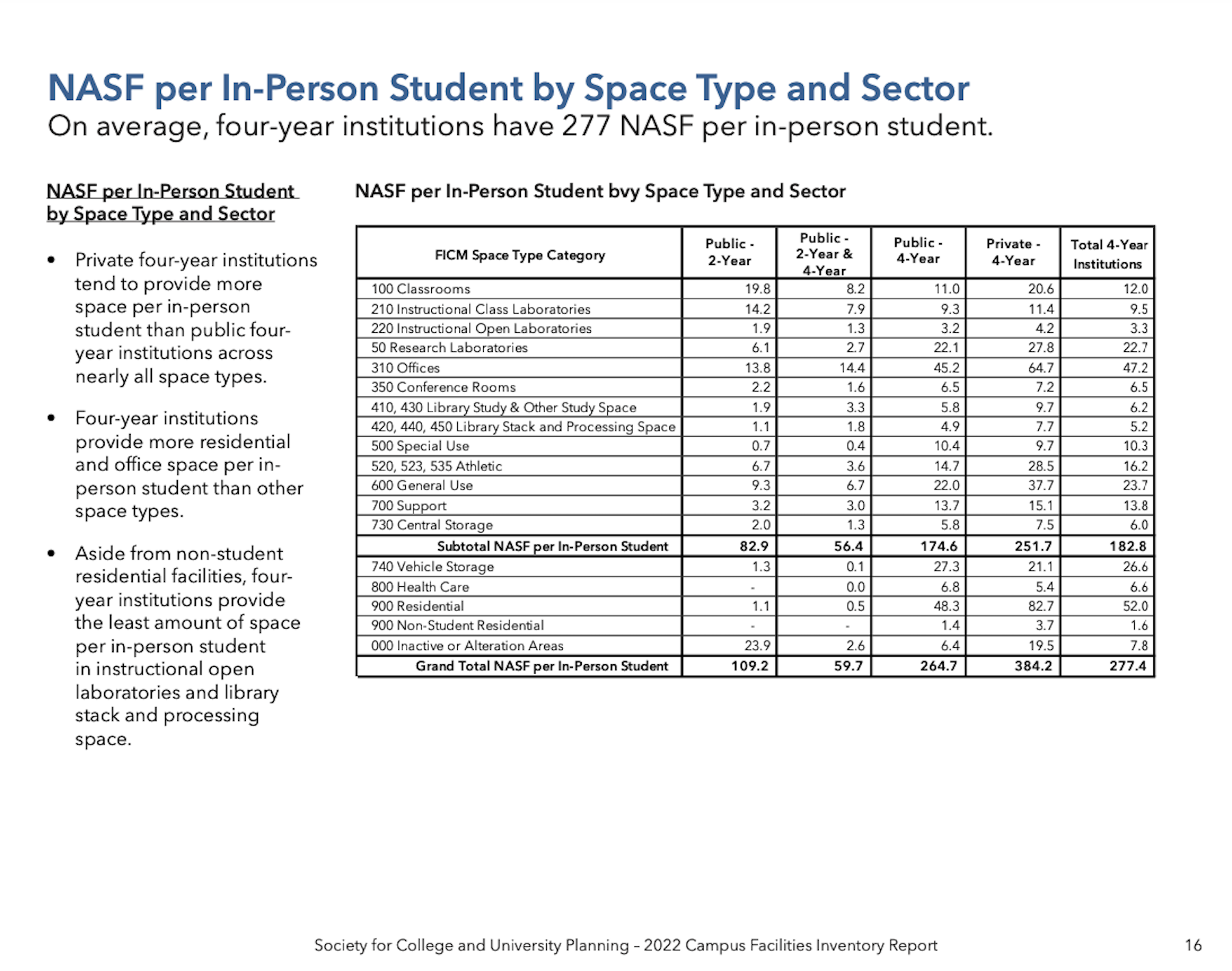
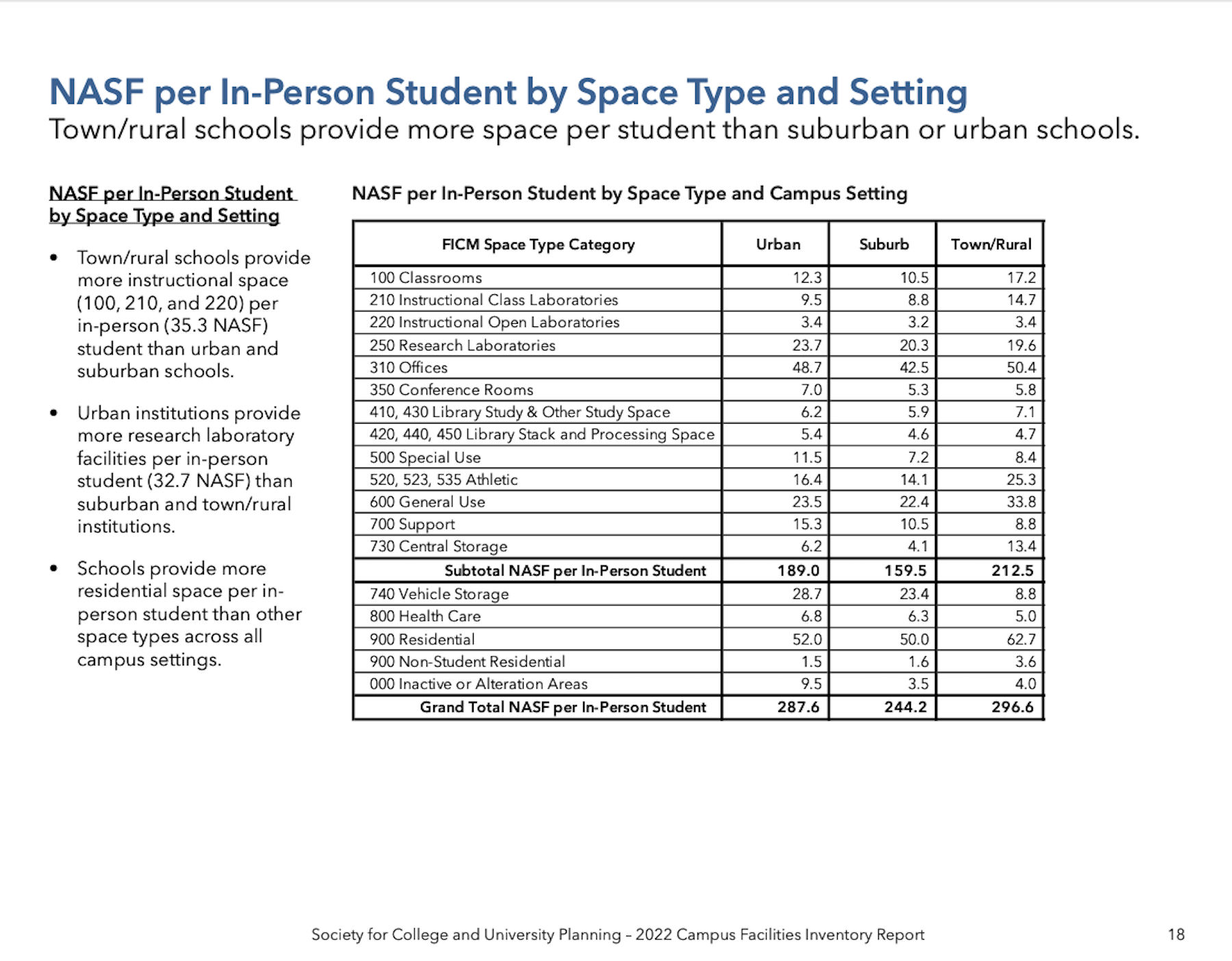
SCUP, a nonprofit professional association that since 1966 has supported college planners, in 2021 partnered with brightspot strategy, a Buro Happold company, to relaunch the Campus Facilities Inventory, (CFI) which originally had been collected and published in 2003-2007. The latest CFI increases the room-use categories tracked to 19, from 15 in the original version. The categories are derived from the National Center for Education Statistics Postsecondary Education Facilities Inventory and Classification Manual.
A sample of the CFI findings shows that small private four-year institutions average 58.7 net aggregate square feet of instructional space per in-person student compared to 35.2 sf that their public counterparts offer.
DEVELOPMENT PLANS GAUGED
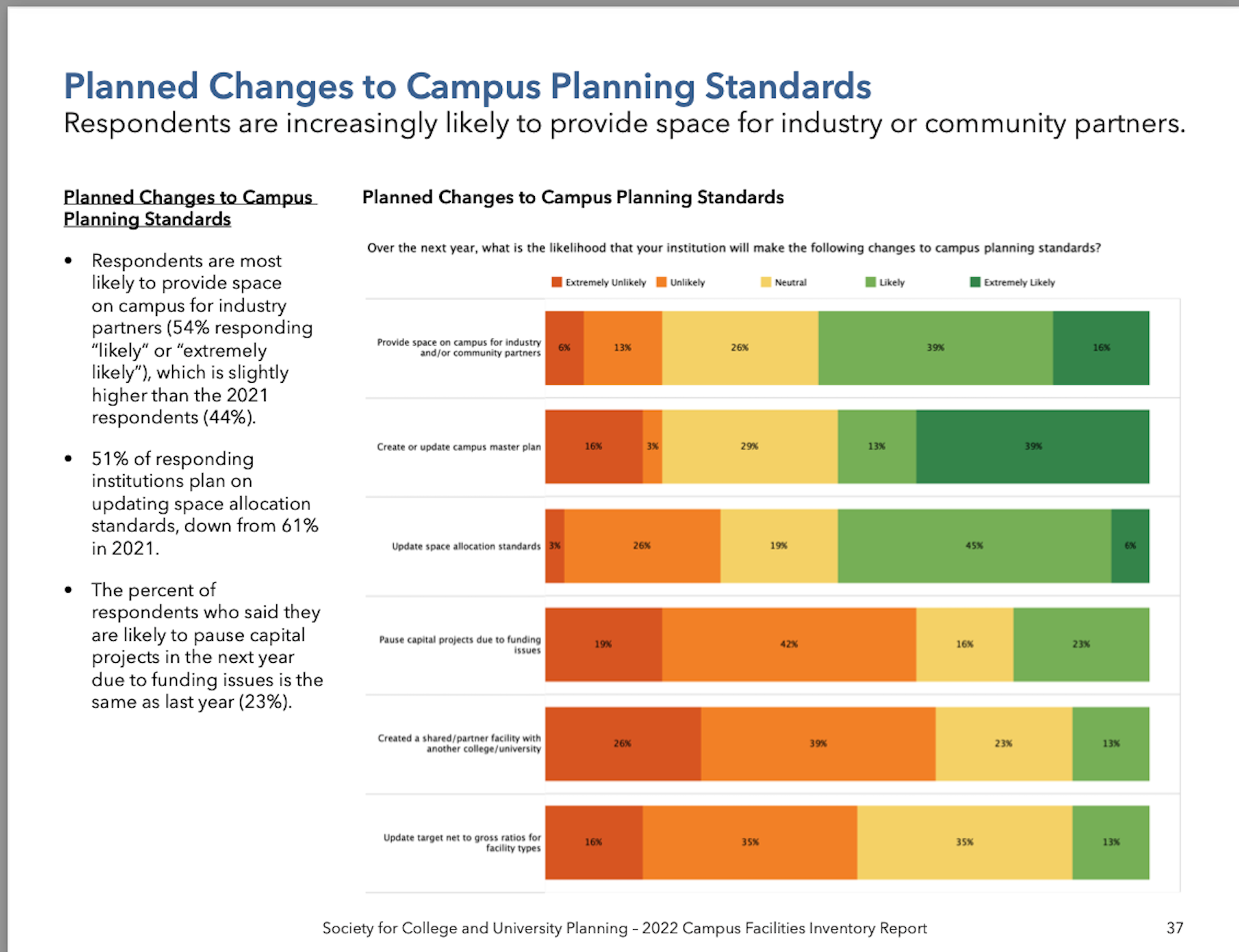
The 2022 Report includes questions about qualitative changes to space on campus—both changes that have been made recently or are likely to be made in the next three years. Thirty-one institutions participated in this part of the survey, the majority of which are four-year public schools. The survey found that respondents are more likely to update or adapt existing facilities, rather than build new ones; are more likely to make changes to administrative office facilities than academic offices; and expect 80 percent of faculty and staff to be working either fully on campus or on campus 3-4 days per week.
Based on responses, investments in campus computing infrastructure and technology systems within facilities are highly likely over the next year. More than half of the respondents said they plan to increase their computational research laboratory and fabrication/maker space facilities. And these respondents also intent to make greater use of outdoor spaces next year.
Interestingly, compared to 2021, more respondents reported decommissioning facilities over the past year. The most common space types for decommissioning were workspaces and research labs. That trend is expected to continue over the following three years.
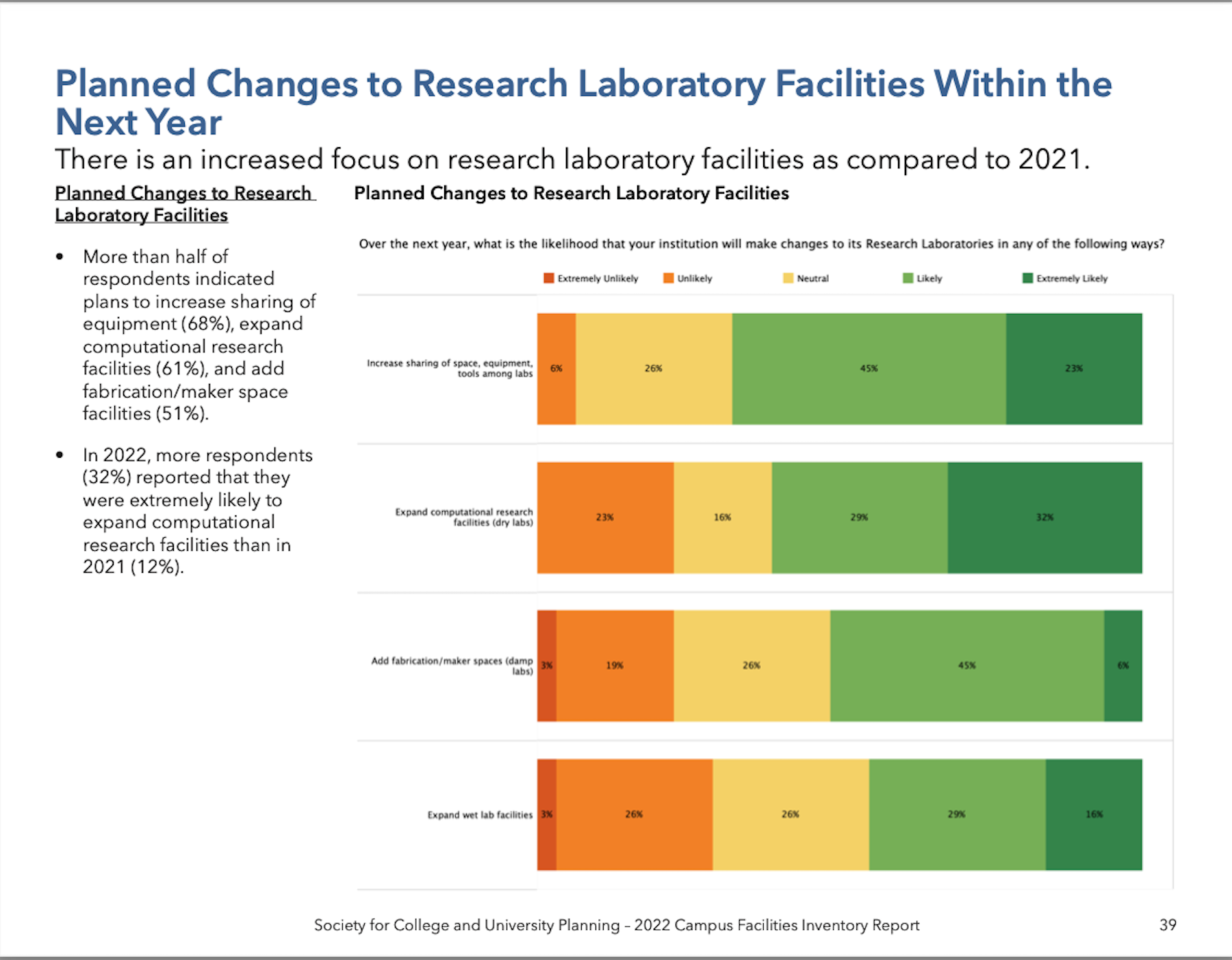
Athletic and recreation facilities moved up to the No. 2 facility type (from No. 7 in 2021) for planned facility updates, right behind classrooms. Adaptive reuse of existing facilities continues to top the list of planned changes to campus facilities, increasing to 84 percent of respondents, from 76 percent in 2021. And when it comes to library and study facilities, respondents are much less likely to move collections off-campus compared to 2021.
ADDING RESEARCH LABS A PRIORITY
Respondents are increasingly likely to provide space for industry or community partners. The 2022 respondents reported a greater focus on research labs, and on updating meeting room technology for virtual engagements.
College planners are also placing greater emphasis on expanding their institutions’ capacities for student health services. While centralizing health and wellness facilities on campus seems to be a nonstarter for many schools, more than two-fifths of respondents plan to design wellness into their student living facilities.
Sadie Wutka, SCUP’s Director of Content Strategy, tells BD+C that while the Society currently collects data yearly, that could change “as we determine the best cadence to provide accurate, timely data without overly burdening the institutions that submit it.
In response to BD+C’s emailed questions, Wutka and Allan Donnelly, brightspot strategy’s Associate Director, wrote that SCUP’s short-term priority is to increase the number of survey respondents “so we can develop a more robust data source.” SCUP is exploring new ways to aggregate data to make the information more useful to institutions, such as reporting out space use per region in the U.S.
Aside from the CFI Report, SCUP creates a range of learning opportunities, said Wukta, that includes publications and the Society’s annual conference.
VOLATILE ENVIRONMENT
Wutka said that the coronavirus pandemic accelerated changes that were already impacting higher education “and launched us into an even more intensely volatile, uncertain, complex, and ambiguous environment.” She pointed specifically to the “demographic cliff”—the decreasing numbers of adolescent students—that Northeastern and Midwestern institutions are now staring into. Other institutions are facing challenges related to state legislation and funding appropriations cuts.
“Higher education institutions need to anticipate the trends and movements that will impact them, and develop an integrated planning culture that builds relationships, aligns the institution, and prepares them to change and adapt,” said Wutka and Donnelly.
SCUP is currently into its 2018-2023 strategic plan that Wutka said has been “instrumental” in helping the Society and its members weather the pandemic. “We pivoted to remote conferences, reintroduced webinar programming, and developed an emerging leader program,” as well as SCUP Coaching, which helps institutions tackle planning challenges. Wukta said SCUP will initiate the process for its next five-year plan this coming fall.
Related Stories
| Oct 12, 2010
Holton Career and Resource Center, Durham, N.C.
27th Annual Reconstruction Awards—Special Recognition. Early in the current decade, violence within the community of Northeast Central Durham, N.C., escalated to the point where school safety officers at Holton Junior High School feared for their own safety. The school eventually closed and the property sat vacant for five years.
| Oct 12, 2010
University of Toledo, Memorial Field House
27th Annual Reconstruction Awards—Silver Award. Memorial Field House, once the lovely Collegiate Gothic (ca. 1933) centerpiece (along with neighboring University Hall) of the University of Toledo campus, took its share of abuse after a new athletic arena made it redundant, in 1976. The ultimate insult occurred when the ROTC used it as a paintball venue.
| Oct 12, 2010
Owen Hall, Michigan State University, East Lansing, Mich.
27th Annual Reconstruction Awards—Silver Award. Officials at Michigan State University’s East Lansing Campus were concerned that Owen Hall, a mid-20th-century residence facility, was no longer attracting much interest from its target audience, graduate and international students.
| Oct 12, 2010
Cell and Genome Sciences Building, Farmington, Conn.
27th Annual Reconstruction Awards—Silver Award. Administrators at the University of Connecticut Health Center in Farmington didn’t think much of the 1970s building they planned to turn into the school’s Cell and Genome Sciences Building. It’s not that the former toxicology research facility was in such terrible shape, but the 117,800-sf structure had almost no windows and its interior was dark and chopped up.
| Oct 12, 2010
Full Steam Ahead for Sustainable Power Plant
An innovative restoration turns a historic but inoperable coal-burning steam plant into a modern, energy-efficient marvel at Duke University.
| Oct 6, 2010
From grocery store to culinary school
A former West Philadelphia supermarket is moving up the food chain, transitioning from grocery store to the Center for Culinary Enterprise, a business culinary training school.
| Sep 16, 2010
Green recreation/wellness center targets physical, environmental health
The 151,000-sf recreation and wellness center at California State University’s Sacramento campus, called the WELL (for “wellness, education, leisure, lifestyle”), has a fitness center, café, indoor track, gymnasium, racquetball courts, educational and counseling space, the largest rock climbing wall in the CSU system.
| Sep 13, 2010
Community college police, parking structure targets LEED Platinum
The San Diego Community College District's $1.555 billion construction program continues with groundbreaking for a 6,000-sf police substation and an 828-space, four-story parking structure at San Diego Miramar College.
| Sep 13, 2010
Campus housing fosters community connection
A 600,000-sf complex on the University of Washington's Seattle campus will include four residence halls for 1,650 students and a 100-seat cafe, 8,000-sf grocery store, and conference center with 200-seat auditorium for both student and community use.
| Sep 13, 2010
China's largest single-phase hospital planned for Shanghai
RTKL's Los Angles office is designing the Shanghai Changzheng New Pudong Hospital, which will be the largest new hospital built in China in a single phase.


